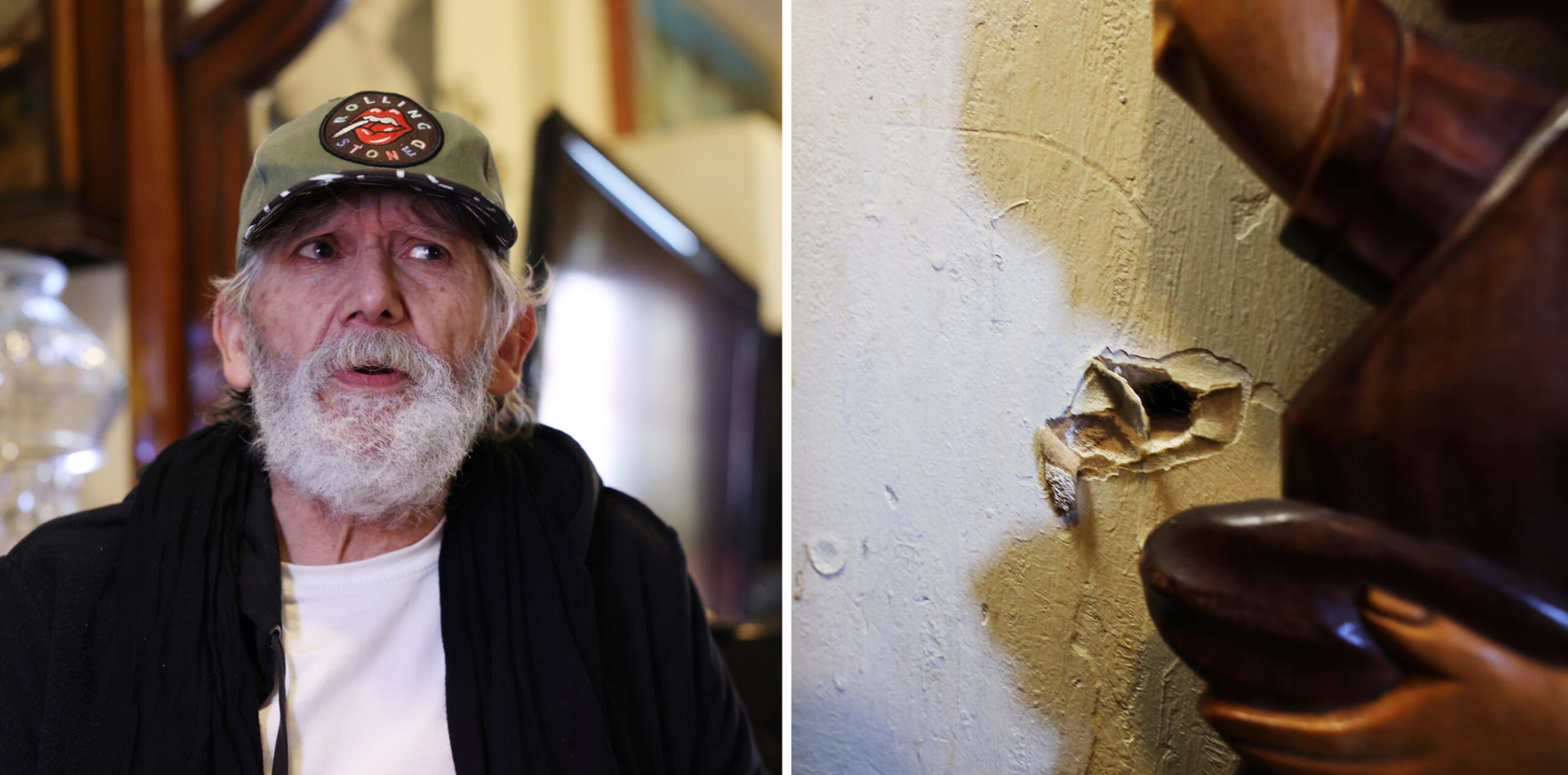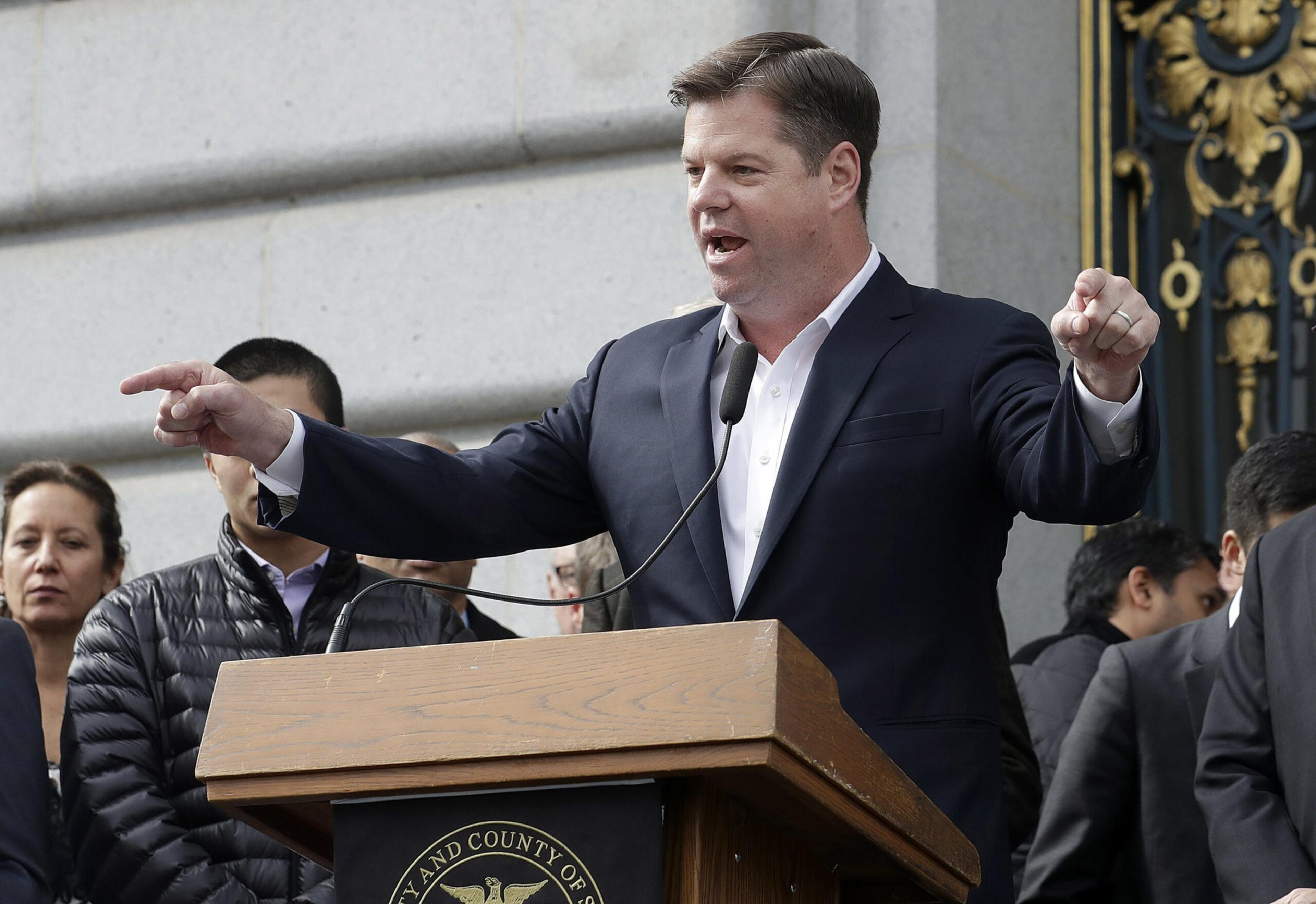Ernest Archer was watching television a few months ago when he heard a “popping sound” and felt a bite on his back. The 71-year-old resident of Hotel Isabel, a single-room occupancy (SRO) building in San Francisco’s South of Market area, knew the feeling well.
Archer and other tenants of Hotel Isabel, which is run by the affordable housing nonprofit Tenants and Owners Development Corporation (TODCO), said it’s not uncommon for roaches and vermin to crawl through the building’s electrical outlets and that complaints to management often went nowhere.
“It’s terrible to wake up in the middle of the night with a mouse on your chest,” Archer said.
But the bite on his back last winter didn’t come from a rodent. Archer said it was a bullet that ripped through the wall of a neighboring apartment and lodged itself just below his left shoulder.

Angelique Mayweather has her own horror stories. Getting an apartment in Hotel Isabel six years ago offered her a lifeline from the streets. But since moving in, she said, conditions have deteriorated: The tap water has a foul taste, and management has failed to address infestations of rats and roaches burrowing holes into her room—and sometimes crawling into her food.
“There’s nothing you can do,” Mayweather said. “The rats are in the walls.”
A review of complaints with the SF Department of Building Inspection confirmed that the eight SoMa properties owned by TODCO, which has $48.5 million in assets and receives multimillion dollar contracts from the city and U.S. Department of Housing and Urban Development, have repeatedly had issues with infestations, mold and heating in recent years. Even more disturbing, 15 people have died from drug overdoses at TODCO buildings since the beginning of 2020, according to data obtained from the San Francisco Chief Medical Examiner’s Office.
“They say drug use is prohibited in the building,” said a woman who has lived in Hotel Isabel for three years and asked not to be named for fear of retribution. “It’s part of the rules, but they don’t do nothing about it.”
All of these incidents—overdoses, pest infestations and generally deteriorating conditions—have taken place as TODCO ramped up spending on political campaigns at the expense of investing in its buildings and the health and safety of its poverty-stricken tenants. In one instance, a 57-year-old man’s body was found (opens in new tab) days after he overdosed—his apartment filled with insects.

Internal financial records show that annual revenue for TODCO’s main nonprofit entity has more than doubled over the last decade while it has steadily reduced the share of revenue it spends on its residents, who are low-income and disabled seniors and formerly homeless people. Meanwhile, the nonprofit has splurged on lobbying, political campaigns, salaries for executives and grants to other political groups. TODCO also appears to have underreported the value of a free apartment given to its leader.
The Standard launched an investigation into TODCO’s complex web of assets after one of the organization’s six nonprofits was found to be delinquent in filing forms and making payments to the California Attorney General’s Registry of Charitable Trusts. By law, nonprofits that are delinquent are barred from spending or receiving funds, and TODCO has multimillion-dollar contracts with the city.
In many ways, TODCO offers a case study of how nonprofits in San Francisco can leverage huge sums of taxpayer dollars for political activity while neglecting their core mission. The organization has been especially successful in exploiting the city’s housing processes to amass money and influence—and, in some ways, oppose development for the sake of financial gain.
How the Money Moves
Few people in San Francisco are as well-versed in the political dark arts as TODCO’s John Elberling.
The housing boss has taken advantage of soaring rental costs, federal subsidies and a refinancing scheme to build a progressive-leaning political empire. His organization, which was created in the early ’70s, has become notorious for blocking market-rate housing projects.
For TODCO and its associated entities, the incentives to block market-rate housing are clear: A lack of housing supply keeps San Francisco’s rents high, and high rents are a big reason why the organization’s revenue has skyrocketed in recent years.
TODCO’s eight properties in SoMa charge fair-market rates, and most of its 900-plus tenants pay 30% of their monthly income. The federal Department of Housing and Urban Development—with some assistance from the city’s Department of Homelessness and Supportive Housing—subsidizes the remaining cost. TODCO has also generated millions in revenue by refinancing three of its properties that were built with federal funds in the ’70s and ’80s and have since grown exponentially in value.
IRS filings going back more than a decade show that as rental costs climbed in San Francisco, TODCO’s main nonprofit entity saw its revenues surge from $2.8 million in 2012-13 to more than $6 million eight years later. Over the same period, the share of revenue TODCO dedicated to resident services plummeted.
TODCO currently has a $1 million contract with San Francisco’s Department of Homelessness and Supportive Housing to provide services to residents in its SRO buildings, including Hotel Isabel.
Records show Elberling and TODCO started pouring more money into staff salaries around the same time it increased its lobbying and other political work. Over an eight-year period, TODCO’s top executive salaries more than tripled, ballooning to more than $777,000—even as its portfolio of properties remained unchanged.
Sam Moss, an affordable housing executive who oversees the Mission Housing Development Corporation, slammed TODCO’s operations when briefed on the way the organization has reprioritized its spending.
“I think for how little work TODCO actually does, the increase for salaries year over year is egregious,” Moss said.
Elberling said in an email that his organization was “understaffed” a decade ago, and that TODCO has added administrative and program staffing in recent years. Much of the property management duties are outsourced to the John Stewart Company, and “management and general” expenses quadrupled from $1 million to $4 million in just eight years.
A woman living at Hotel Isabel said a maintenance worker “does the best he can,” but management waited a year to adequately address roaches in a neighbor’s apartment.
“Roaches were coming out of everywhere,” she said. “Oh, man. I was in tears.”
Elberling said the number of complaints at TODCO’s buildings have been modest and “all were corrected expeditiously.”
Playing Politics
A turning point in TODCO’s transition to a political powerhouse came in 2014, when Elberling launched the Yerba Buena Neighborhood Consortium to act as the organization’s political arm. In the last nine years, the organization and TODCO’s affiliated entities have plowed at least $2.6 million into local elections, according to records with the SF Ethics Commission.
“I would say he has been in a class of his own,” Supervisor Aaron Peskin said of Elberling’s prolific political activity over the last decade.
TODCO was able to resyndicate the debt on three of its federally funded properties—Mendelsohn House, Woolf House and Ceatrice Polite Apartments, which are named after TODCO’s founders—and raise money through tax credits and bonds. The scheme has given Elberling a piggy bank worth millions to draw upon.
“Here is this guy who has all this money, and instead of using it to reinvest in his properties or continue on the mission of his organization, he uses it basically to buy political influence and enjoy the self-aggrandizement that it brings,” said Sonja Trauss, a housing activist and executive director of YIMBY Law (opens in new tab).

Last year, Elberling blew nearly a half-million dollars on a flawed ballot measure to tax Amazon. Instead, it would have dinged small businesses and was ultimately struck from the ballot. The TODCO boss essentially shrugged it off as chump change, even though this money could have gone toward helping tenants.
In many cases, TODCO’s political money has gone toward obvious progressive causes like fighting real estate interests in San Francisco and attempting to raise the city’s minimum wage. Elberling said that one of his organization’s biggest political victories came in March 2020, when voters passed Proposition E to put a cap on office development in SoMa until more affordable housing is built.
But other campaigns that TODCO supported seem to have little to do with helping its residents or building more affordable housing in San Francisco.
Most recently, TODCO unsuccessfully attempted to lower the voting age in San Francisco and poured thousands into ballot measures in Berkeley, Oakland and Southern California, where it doesn’t own properties.
TODCO also spends tens of thousands in election cycles on polling that it shares with its political allies at City Hall, along with mailers that serve to prop up preferred candidates under the guise of issue-driven campaigns. Nonprofits are barred from explicitly supporting individual candidates.

A review of IRS records showed that TODCO spent just $5,000 to lobby government officials back in 2012-13, but that figure mushroomed to more than $473,000 eight years later.
Lobbyist disclosure forms filed with the California Secretary of State shows TODCO paid the Sacramento-based firm Resolute $87,000 in 2020 to lobby state officials, and another $180,000 for all of 2021. Elberling said the IRS classifies ballot measure expenses as lobbying.
Nonprofit experts who were contacted for this story said Elberling’s political activity appears to be legal, though it may raise ethical concerns.
Joan Harrington, a nonprofit expert and former director at the Markkula Center for Applied Ethics at Santa Clara University, said she appreciates TODCO advocating for low-income people, “but I think the question is: How much is that population actually benefiting?”
San Francisco City Hall and housing officials were alarmed to learn just how starkly TODCO’s spending priorities have changed over the years. Many questioned whether San Francisco and the federal Department of Housing and Urban Development should continue funding a nonprofit that has grown so overtly political.
“Let’s be clear: Taxpayer dollars must be used for essential services, not for personal or political gain,” Supervisor Catherine Stefani said in a statement to The Standard. “It is unconscionable that city contractors would allegedly divert funds meant to protect low-income tenants to subsidize their lobbying efforts. This is exactly why San Franciscans have so many questions about where their money is going, and I intend to put a stop to it.”
Throwing Shade
As some of TODCO’s properties have fallen into disrepair, the nonprofit has exploited San Francisco’s notoriously byzantine process for housing development to derail projects and grow its own coffers. TODCO has often attempted to do this work in the shadows—and its leader, Elberling, is an expert on shade.
In 2018, developers of an eight-story hotel and mixed-use building at 744 Harrison St. agreed to pay TODCO $98,810 in exchange for the nonprofit dropping objections over “new shadows” the structure might cast on the Alice Street Community Gardens. It’s unclear how substantial the shadows would be, as the gardens are about 500 feet away and located northeast of the project. But the settlement would serve as practice for a bigger fight to come.
In a well-publicized incident, TODCO orchestrated a controversial 2021 vote in which city supervisors denied a 495-unit development on Stevenson Street. Elberling led the fight to crush the project, raising objections ranging from earthquake concerns and doubts about construction costs to worries about shadows the building would cast on neighboring Mint Plaza.
The Board of Supervisors’ decision to deny the project and let the property sit idle as an empty parking lot solidified TODCO’s reputation in pro-housing development circles as an enemy of the good.
Deconstructing how exactly TODCO funds these fights is difficult to determine due to a complex financial structure it created through the Yerba Buena Neighborhood Consortium and six nonprofit entities, including an inactive entity with $1.1 million in assets called the Yerba Buena Housing Sites Trust. A nonprofit expert called this nonprofit “peculiar” because it appears to exist only to collect interest.

Most of TODCO’s nonprofit affiliates were created in 2015 as the organization began to flex its political muscle. In one instance, TODCO’s main nonprofit gave a $100,000 grant to a political group to wage a coordinated lawsuit.
According to an IRS filing for 2020-21, TODCO gave the grant to the Haight-Ashbury Neighborhood Council (HANC), a progressive political group. Calvin Welch, who serves on HANC’s board and oversees housing and land use for the organization, said the grant was intended to fund a lawsuit against the expansion of the UCSF Parnassus campus.
But in giving the grant, TODCO identified HANC as a 501c3 nonprofit in IRS records. HANC had its charitable status revoked by the state Attorney General’s Office more than a decade ago, and the IRS revoked the organization’s nonprofit status last spring for failure to file forms for multiple years. Nonprofit experts contacted for this story said this donation might have violated restrictions on the use of nonprofit funds.
If the grant did not violate the law, experts said, it would still be unethical for a nonprofit getting millions in city and federal funds to divert that money to an organization barred from applying for those same funds.
Elberling said in an email that TODCO made the grant “in good faith based on [HANC’s] representation.”
Harrington, a nonprofit expert, said that charities “have to do their due diligence” before making such contributions.
“If their mission is to protect their clients and promote housing,” she added, “it is hard to see how their actions are the best way to achieve this.”
Moss, who has been strident in his criticism of TODCO’s prioritization of politics, had a more blunt assessment.
“TODCO has a legal responsibility to take care of its buildings to the best of its ability,” Moss said. “And the best of TODCO’s ability is not giving Calvin Welch $100,000 to burn in John Elberling’s backyard.”
Who’s on Board?
John Elberling stepped down as CEO of TODCO sometime in the last two years, but still retains the title of president, and people close to the organization said he is still pulling all the strings. But who exactly checks him on the nonprofit’s use of funds is an open question.
It’s unclear who currently serves on TODCO’s board, as its website and most recently available IRS filings list different individuals. Elberling did not respond to questions about the board.
The shifting roster appears to include: a lobbyist who served under former Supervisor Jane Kim, who was accused of illegally lobbying for TODCO after leaving City Hall; the director of the Felton Institute, which has been embroiled in an ugly labor dispute with its workers (opens in new tab); a few people whose qualifications appear to involve working in the arts; and a TODCO tenant in her 90s.
“In a nonprofit 501c3, the board is ultimately responsible for the organization,” Harrington said. “They can be sued for things that go awry if they’re not meeting their fiduciary duties.”

In 2016, then-Supervisor Mark Farrell called for a federal investigation into the nonprofit’s funneling of “dark money” into ballot measure campaigns. It’s unclear if any investigation took place, but a question many have asked over the years is why the city and the U.S. Department of Housing and Urban Development are turning a blind eye to TODCO when the organization has clearly made political campaigns its top priority.
Archer, who continues to live in TODCO’s Hotel Isabel despite the rats, roaches and being shot in the back, is among those tenants who could benefit from investments in a safer and healthier living space.
“It’s a heck of a lot better than being on the streets,” Archer said. “But that’s not saying much.”
